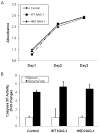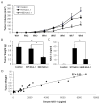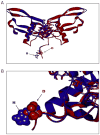The H6D variant of NAG-1/GDF15 inhibits prostate xenograft growth in vivo
- PMID: 21809352
- PMCID: PMC3209492
- DOI: 10.1002/pros.21471
The H6D variant of NAG-1/GDF15 inhibits prostate xenograft growth in vivo
Abstract
Background: Non-steroidal anti-inflammatory drug-activated gene (NAG-1), a divergent member of the transforming growth factor-beta superfamily, has been implicated in many cellular processes, including inflammation, early bone formation, apoptosis, and tumorigenesis. Recent clinical studies suggests that a C to G single nucleotide polymorphism at position 6 (histidine to aspartic acid substitution, or H6D) of the NAG-1 protein is associated with lower human prostate cancer incidence. The objective of the current study is to investigate the activity of NAG-1 H6D variant in prostate cancer tumorigenesis in vivo.
Methods: Human prostate cancer DU145 cells expressing the H6D NAG-1 or wild-type (WT) NAG-1 were injected subcutaneously into nude mice and tumor growth was monitored. Serum and tumor samples were collected for subsequent analysis.
Results: The H6D variant was more potent than the WT NAG-1 and inhibited tumor growth significantly compared to control mice. Mice with tumors expressing the WT NAG-1 have greater reduced both body weight and abdominal fat than mice with H6D variant tumors suggesting different activities of the WT NAG-1 and the H6D NAG-1. A significant reduction in adiponectin, leptin, and IGF-1 serum levels was observed in the tumor-bearing mice with a more profound reduction observed with expression of H6D variant. Cyclin D1 expression was suppressed in the tumors with a dramatic reduction observed in the tumor expressing the H6D variant.
Conclusion: Our data suggest that the H6D variant of NAG-1 inhibits prostate tumorigenesis by suppressing IGF-1 and cyclin D1 expression but likely additional mechanisms are operative.
Copyright © 2011 Wiley Periodicals, Inc.
Figures






Similar articles
-
The diverse roles of nonsteroidal anti-inflammatory drug activated gene (NAG-1/GDF15) in cancer.Biochem Pharmacol. 2013 Mar 1;85(5):597-606. doi: 10.1016/j.bcp.2012.11.025. Epub 2012 Dec 7. Biochem Pharmacol. 2013. PMID: 23220538 Free PMC article. Review.
-
Macrophage inhibitory cytokine-1 H6D polymorphism, prostate cancer risk, and survival.Cancer Epidemiol Biomarkers Prev. 2006 Jun;15(6):1223-5. doi: 10.1158/1055-9965.EPI-06-0063. Cancer Epidemiol Biomarkers Prev. 2006. PMID: 16775185
-
Qizhen capsule inhibits colorectal cancer by inducing NAG-1/GDF15 expression that mediated via MAPK/ERK activation.J Ethnopharmacol. 2021 Jun 12;273:113964. doi: 10.1016/j.jep.2021.113964. Epub 2021 Feb 26. J Ethnopharmacol. 2021. PMID: 33640439
-
H6D polymorphism in macrophage-inhibitory cytokine-1 gene associated with prostate cancer.J Natl Cancer Inst. 2004 Aug 18;96(16):1248-54. doi: 10.1093/jnci/djh227. J Natl Cancer Inst. 2004. PMID: 15316060
-
The H6D genetic variation of GDF15 is associated with genesis, progress and prognosis in colorectal cancer.Pathol Res Pract. 2015 Nov;211(11):845-50. doi: 10.1016/j.prp.2015.08.004. Epub 2015 Sep 5. Pathol Res Pract. 2015. PMID: 26365480
Cited by
-
GDF15: A Hormone Conveying Somatic Distress to the Brain.Endocr Rev. 2020 Aug 1;41(4):bnaa007. doi: 10.1210/endrev/bnaa007. Endocr Rev. 2020. PMID: 32310257 Free PMC article. Review.
-
Macrophage inhibitory cytokine-1 in cancer: Beyond the cellular phenotype.Cancer Lett. 2022 Jun 28;536:215664. doi: 10.1016/j.canlet.2022.215664. Epub 2022 Mar 26. Cancer Lett. 2022. PMID: 35351601 Free PMC article. Review.
-
The diverse roles of nonsteroidal anti-inflammatory drug activated gene (NAG-1/GDF15) in cancer.Biochem Pharmacol. 2013 Mar 1;85(5):597-606. doi: 10.1016/j.bcp.2012.11.025. Epub 2012 Dec 7. Biochem Pharmacol. 2013. PMID: 23220538 Free PMC article. Review.
-
Lower NLRP3 inflammasome activity in NAG-1 transgenic mice is linked to a resistance to obesity and increased insulin sensitivity.Obesity (Silver Spring). 2014 May;22(5):1256-63. doi: 10.1002/oby.20638. Epub 2013 Dec 5. Obesity (Silver Spring). 2014. PMID: 24124102 Free PMC article.
-
Whole-exome sequencing uncovers new variants in GDF15 associated with hyperemesis gravidarum.BJOG. 2022 Oct;129(11):1845-1852. doi: 10.1111/1471-0528.17129. Epub 2022 Mar 16. BJOG. 2022. PMID: 35218128 Free PMC article.
References
-
- Cancer Facts and Figures. 2010.
-
- Piek E, Heldin CH, Ten Dijke P. Specificity, diversity, and regulation in TGF-beta superfamily signaling. Faseb J. 1999;13(15):2105–2124. - PubMed
-
- Eling TE, Baek SJ, Shim M, Lee CH. NSAID activated gene (NAG-1), a modulator of tumorigenesis. J Biochem Mol Biol. 2006;39(6):649–655. - PubMed
-
- Bauskin AR, Zhang HP, Fairlie WD, He XY, Russell PK, Moore AG, Brown DA, Stanley KK, Breit SN. The propeptide of macrophage inhibitory cytokine (MIC-1), a TGF-beta superfamily member, acts as a quality control determinant for correctly folded MIC-1. The EMBO journal. 2000;19(10):2212–2220. - PMC - PubMed
Publication types
MeSH terms
Substances
Grants and funding
LinkOut - more resources
Full Text Sources
Medical
Research Materials
Miscellaneous

